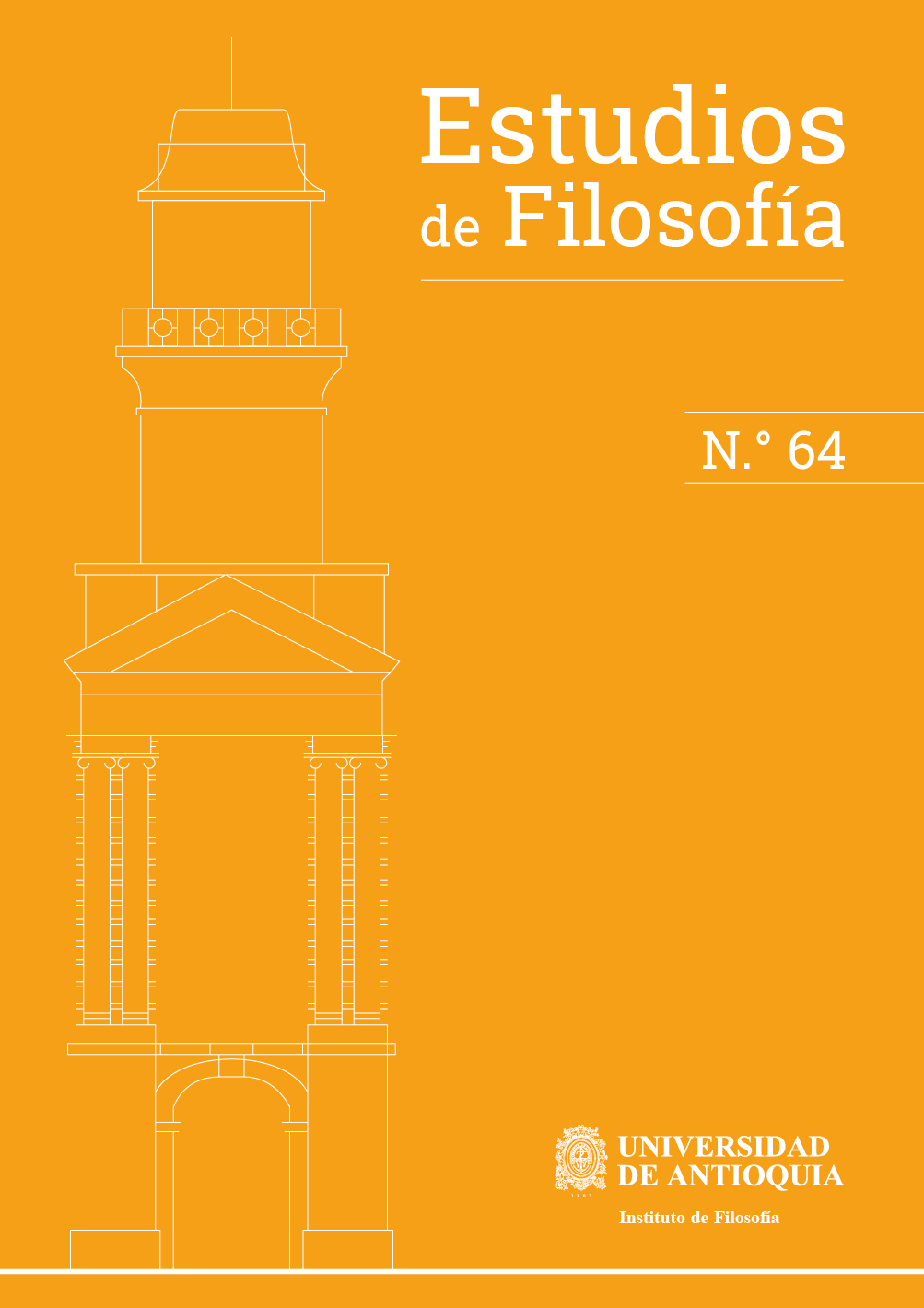No hay mapas para estos territorios: una exploración de la filosofía de la memoria a través de la fotografía
DOI:
https://doi.org/10.17533/udea.ef.n64a03Palabras clave:
fotografía, arte, memoria, memoria cultural, percepciónResumen
Al inicio se examina la percepción de las fotografías desde dos direcciones: qué pensamos que son las fotografías y los aspectos de la mente involucrados al ver fotografías. Se muestra que las fotografías tradicionales son herramientas mnemónicas: por ello, la memoria es una parte clave del proceso mediante el cual las fotografías se perciben por completo. En segundo lugar, describo el metamorfograma; una fotografía no tradicional que se ajusta a criterios específicos definidos por el autor para ser memoria. Se muestra que el metamorfograma es análogo a una combinación de todos los recuerdos episódicos de un individuo. Finalmente, el uso del metamorfograma en obras artísticas sugiere una relación bidireccional entre la memoria autobiográfica individual y la memoria cultural compartida. Un modelo de esta relación no se alinea con las definiciones existentes de memoria cultural y puede representar una nueva forma: la memoria sociobiográfica. Propongo que las experiencias aquí documentadas justifican la promoción de una relación mutuamente beneficiosa entre la filosofía y otras disciplinas creativas, incluida la fotografía.
Descargas
Citas
Adams, S. (2019). A note on Ricœur’s early notion of cultural memory. Études Ricoeuriennes / Ricoeur Studies, 10(1), 112-124. https://doi.org/10.5195/errs.2019.465
Alea, N. & Wang, Q. (2015). Going global: the functions of autobiographical memory in cultural context. Memory, 23(1),1-10. PMID: 25585205. https://doi.org/10.1080/09658211.2014.972416
Assmann, A. (2006). Memory, individual and collective. In R. E. Goodin & Ch. Tilly (Eds.), The Oxford Handbook of Contextual Political Analysis (pp. 210-224). Oxford University Press. https://doi.org/10.1093/oxfordhb/9780199270439.003.0011
Barthes, R. (1980) Camera Lucida. Vintage Books.
Baudrillard, J. (1998) Paroxysm. Verso, London.
Berger, J. (1980). About looking. Pantheon Books. https://doi.org/10.3817/1280046209
Fawns, T. (2020). Blended memory: a framework for understanding distributed autobiographical remembering with photography. Memory Studies, 13(6), 901-916. https://doi.org/10.1177/1750698019829891
Garry, M. & Gerrie, M. P. (2005). When photographs create false memories. Current Directions in Psychological Science, 14(6), 321–325. https://doi.org/10.1111/j.0963-7214.2005.00390.x
Gibson, W. (2012). Distrust that particular flavour. G. P. Puttnam’s Sons.
Heersmink, R. (2020). Extended mind and artifactual autobiographical memory. Mind and
Language, 36,1-15. https://doi.org/10.1111/mila.12353
Heersmink, R. & McCarroll, C. J. (2019). The best memories: identity, narrative, and objects. In T. Shanahan & P. Smart (Eds.), Blade Runner 2049: a philosophical exploration (pp. 87-107). Routledge. https://doi.org/10.4324/9780429460036-6
Hoskins, J. (2005). Agency, biography and objects. In C. Tiller, W. Keane, S. Küchler, M. Rowlands & P. Spyer (Eds.), Handbook of Material Culture (pp. 74-84). SAGE. https://doi.org/10.4135/9781848607972.n6
Manier, D. & Hirst, W. (2008). A cognitive taxonomy of collective materials. In A. Erll & A. Nünning (Eds.), Cultural Memory Studies: An international and interdisciplinary handbook (pp. 253-362). De Gruyter.
Rowlands, M. (2016). Memory and the self: phenomenology, science and autobiography. Oxford University Press. https://doi.org/10.1093/acprof:oso/9780190241469.001.0001
St. Jacques, P. L. & Schacter, D. L. (2013). Modifying memory: selectively enhancing and updating personal memories for a museum tour by reactivating them. Psychological Science, 24(4), 537–543. https://doi.org/10.1177/0956797612457377
St Jacques, P. L., Montgomery, D. & Schacter, D. L. (2015). Modifying memory for a museum tour in older adults: reactivation-related updating that enhances and distorts memory is reduced in ageing. Memory, 23(6), 876–887. https://doi.org/10.1080/09658211.2014.933241
Sasaki, M & DiCicco, S. (2020). The complete story of Sadako Sasaki and the thousand paper cranes. Tuttle Publishing.
Sontag, S. (1979) On photography (electronic edition, 2005) Rosetta Books.
Sutton, J. (1998). Philosophy and memory traces: Descartes to connectionism. Cambridge University Press.
Wang, Q. (2021). The cultural foundation of human memory. Annual Review of Psychology, 72, 151–179. https://doi.org/10.1146/annurev-psych-070920-023638
Whittaker, S., Bergman, O. & Clough, P. (2010) Easy on that trigger dad: a study of long term family photo retrieval. Pers Ubiquit Comput, 14, 31–43. https://doi.org/10.1007/s00779-009-0218-7
Zhang, M. & Cross S. E. (2011). Emotions in memories of success and failure: a cultural perspective. Emotion, 11(4), 866-80. https://doi.org/10.1037/a0024025
Descargas
Publicado
Cómo citar
Número
Sección
Categorías
Licencia
Derechos de autor 2021 Alun Kirby

Esta obra está bajo una licencia internacional Creative Commons Atribución-NoComercial-CompartirIgual 4.0.
Los autores que publican en Estudios de Filosofía acuerdan los siguientes términos:
1. El Autor retiene el copyright del "Artículo", por el cual se entiende todos los objetos digitales que pueden resultar de la subsiguiente publicación o distribución electrónica.
2. En conformidad con los términos de este acuerdo, el autor garantizará a Estudios de Filosofía como Editor el derecho de la primera publicación del artículo.
3. El Autor le concederá al Editor un derecho perpetuo y no-exclusivo, así como una licencia de la misma clase, de publicar, archivar y hacer accesible el Artículo parcial o totalmente en todos los medios conocidos o por conocerse, derecho y licencia que se conocen como Creative Commons License Deed. Atribución-No Comercial- Compartir igual CC BY-NC-SA o su equivalente que para efectos de eliminar toda duda, le permite a otros copiar, distribuir, y transmitir el Artículo bajo las siguientes condiciones: (a) Atribución: Se deben reconocer los créditos de la obra de la manera especificada por el Autor a Estudios de Filosofía, pero no de una manera que sugiera que tiene su apoyo o que apoyan el uso que hace de su obra. (b) No Comercial: No se puede utilizar el Artículo para fines comerciales.
4. El Autor puede realizar otros acuerdos contractuales no comerciales para la distribución no exclusiva de la versión publicada del Artículo (v. gr. ponerlo en un repositorio institucional o publicarlo en un libro) con la condición de que haga el debido reconocimiento de su publicación original en Estudios de Filosofía.
5. A los Autores se les permite y Estudios de Filosofía promueve publicar en línea (online) la versión pre-impresa del Artículo en repositorios institucionales o en sus páginas web, antes y durante la publicación, por cuanto que puede producir intercambios académicos productivos, así como una mayor citación del Artículo publicado (ver The Effect of Open Access). Dicha publicación durante el proceso de producción y en la publicación del Artículo se espera que se actualice al momento de salir la versión final, incluyendo una referencia a la URL de Estudios de Filosofía.















